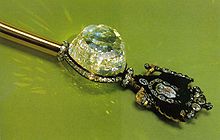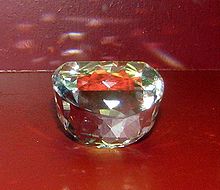Orlov diamond
The Orlov diamond (also known as the Orloff diamond of Empress Catherine II ) is a 189.62 carat (37.924 g) diamond. The stone is one of the world's most famous diamonds, together with the Florentines of the Medici , the blue Hope Diamond , the Sancy and the Dresden Green Diamond .
Legend

According to a legend , the bluish-greenish diamond belonged to the statue of the Indian deity Brahma . The eyes of the gods statue in the temple of Mysore were adorned with two large diamonds of great value. A French mercenary who allegedly for Hindu faith had converted to be admitted to the temple should broken the stone out of the left eye, and stole it in 1750 then Madras have sold to a British trade-captain. The stone came to Antwerp , where Prince Grigory Grigoryevich Orlov , who together with his brother Alexei played a key role in the overthrow of Tsar Peter III. was involved, bought it and gave it to Tsarina Catherine II, the Great in 1776 . But he did not regain the favor of the Empress, which he had previously lost. Tsarina Katharina had the Orlov diamond , as it was henceforth called, worked into the tip of the golden scepter of the Russian tsars.
Since 1967, the Orlov diamond has been exhibited in the permanent exhibition of the Diamond Fund in the Armory of the Moscow Kremlin .
Worth mentioning
- As the Indian deity Brahma whose left eye was stolen, the deity is said to have the future owners misfortune predicted. The numerous assassinations on the Russian Tsar's house are therefore attributed to the curse on the stone.
- The Mughal , a diamond of 280 carats described by Jean-Baptiste Tavernier , is said to have been found in 1650 in the Kollur mine at Kistnah in India. At the court of Aurangzeb Tavernier had it in hand. He describes it as a round stone cut in the shape of a rose. The current whereabouts are unknown and it is sometimes assumed that the Orlov diamond was cut from the Great Mughal.
- The diamond plays an important role in the operetta Der Orlow by Bruno Granichstaedten , which premiered in 1925 at the Theater an der Wien : According to the (of course fictitious) plot, the American car manufacturer John Walsh is in love with the Russian dancer Nadja; however, she is only interested in his machinist Alex Doroschinsky. This is, of course, in reality the Grand Duke Alexander Alexandrowitsch, who lost all of his fortune after the Russian Revolution and had to flee from Russia to America. He could only take the famous Orlov diamond with him. John is now supposed to sell the diamond on behalf of Alex because he needs money to be able to marry Nadja. Alex proposes marriage to her, but she thinks he is a cheater and thief. Only when the true identity of Alex Doroschinsky is revealed, does she ask his forgiveness. The now Grand Duke Alexander Alexandrovich remains irreconcilable at first, but in the end love is stronger than his pride. This operetta was made into a film in 1927 and 1932 ( The Tsar's Diamond ).
See also
literature
- Anna Malecka, Did Orlov buy the Orlov , in: Gems and Jewelery, vol. 23 (6), July 2014 10-12.
- Anna Malecka, The Great Mughal and the Orlov: One and the Same Diamond? , The Journal of Gemmology, vol. 35, no.1 (2016), 56-63.
- Edwin Streeter: The Great Diamonds of the World , George Bell & Sons (1898)
- Ian Balfour: Sources: Famous Diamonds
- George E. Harlow: The Nature of Diamonds
- Max Bauer: Precious Stones
- Ronne Peltsman and Neil Grant: Diamonds - Myth, Magic, and Reality

